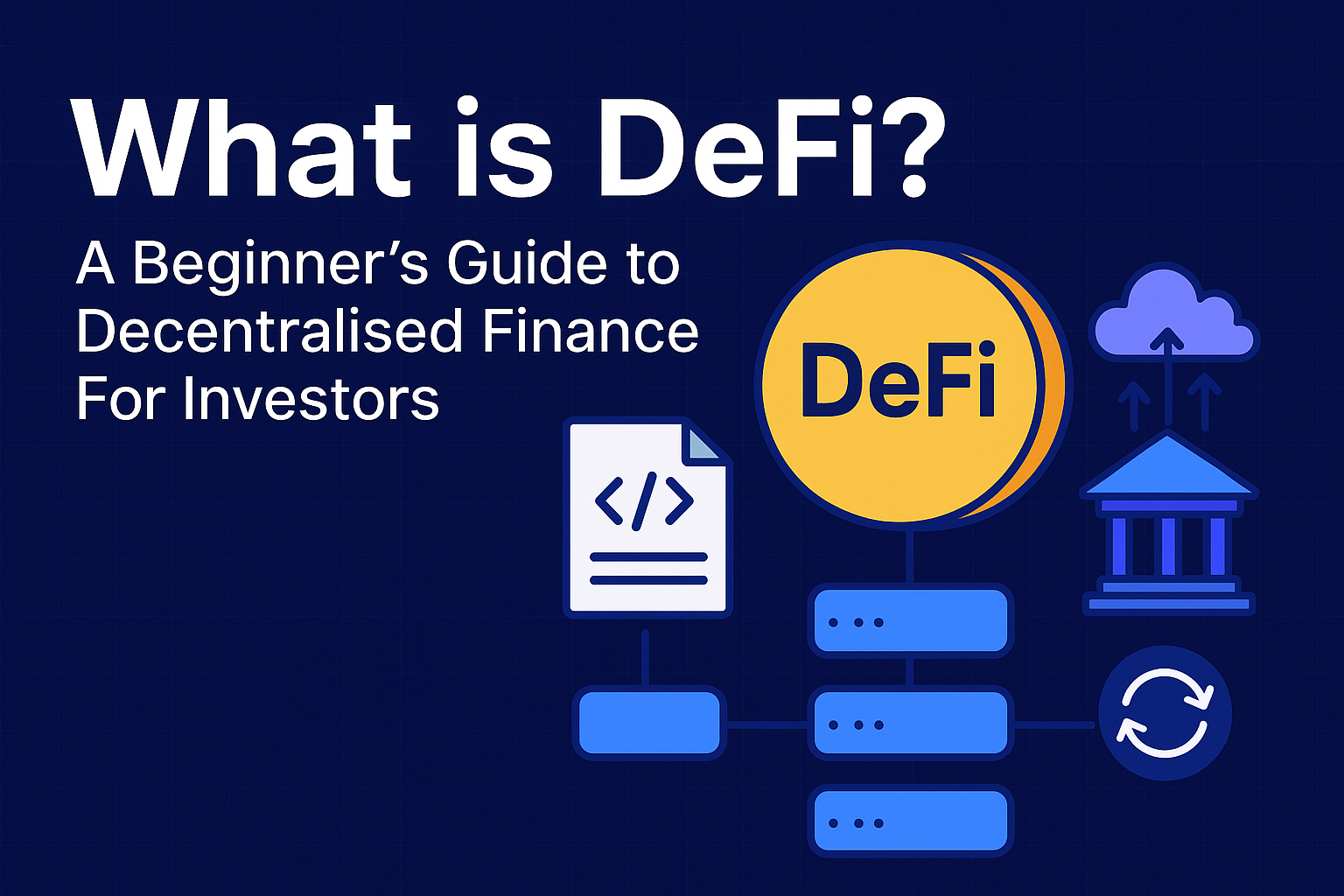Decentralised Finance, better known as DeFi, is one of the most exciting innovations in the world of cryptocurrency and blockchain. It’s changing how people think about money, banking, and investing, offering new opportunities outside of the traditional financial system. But what exactly is DeFi, and why is it so important for the future of finance?
In this guide, we’ll break down what DeFi is, why it matters, and the different types of DeFi applications you should know about.
What is DeFi?
DeFi stands for Decentralised Finance, a system of financial applications built on blockchain technology to recreate financial services (e.g. lending, trading, insurance, derivatives) without traditional intermediaries like banks and financial institutions. They use smart contracts, which are pieces of code that automatically execute transactions on the blockchain when certain conditions are met. It offers openness, composability and new income opportunities, but also unique technical and economic risks
In simple terms: DeFi lets you lend, borrow, trade, and invest directly with others, Peer to Peer, without needing a bank.
Why is DeFi Important for the Future?
DeFi matters because it’s creating a new financial system that is:
-
Open to Everyone – Anyone with an internet connection and a crypto wallet can access DeFi, no matter where they live globally.
-
Transparent – Transactions are recorded on public blockchains, making them verifiable and harder to manipulate.
-
Efficient – By removing banks and middlemen, transactions can be faster and cheaper.
-
Innovative – DeFi is giving rise to financial products and services that traditional banking cannot easily offer, such as programmable money, tokenised assets, and decentralised exchanges.
As more people adopt blockchain technology, DeFi has the potential to reshape the global economy, offering financial freedom and inclusion on a scale never seen before.
How DeFi works (short technical explanation)
-
Blockchain layer: A public ledger with smart contract capability (e.g. Ethereum and it’s L2s, Solana, Sui) records state and transactions.
-
Smart contracts: Self-executing code that holds funds and enforces rules (e.g. lending parameters).
-
Permissionless & composable: Protocols can interoperate, you can stack services (e.g. provide liquidity on a DEX, then deposit LP tokens into a yield optimiser).
-
Oracles: Services (e.g. Chainlink, Pyth Network) that feed real-world data (prices, rates) to smart contracts. Reliable oracles are critical to avoid price-manipulation attacks.
DeFi Applications For Investors
DeFi isn’t just one thing, it’s an ecosystem of different applications working together. Here are some of the most important examples:
-
Decentralised Exchanges (DEXs): Automated Market Makers (AMM) platforms like Uniswap and SushiSwap let users trade crypto directly without a central exchange using liquidity pools and formulas instead of order books. Users can also earn passive income and support DEXs by providing liquidity, also known as Yield Farming.
-
Lending & Borrowing Protocols: Services such as Aave and Morpho allow users to earn interest by lending crypto or to borrow against their assets as collateral.
-
Stablecoins: Cryptocurrencies like USDC or USDT are pegged to stable assets (like the US dollar) to reduce volatility for transactions and yields.
-
Staking: Methods of earning passive income by locking up tokens to secure networks. May also allow users to participate in governance / voting for protocol decisions.
-
Derivatives & Synthetic Assets: Platforms like Synthetix allow exposure to stocks, commodities, and other Real World Assets (RWA) via blockchain.
DeFi Risks and Mitigation
-
Smart contract risk (bugs/exploits).
Mitigation: Prefer audited, battle-tested protocols; start with small amounts; use multi-sig and timelocks where available. -
Oracle manipulation / price slippage.
Mitigation: Use platforms with robust oracle designs (Chainlink, Pyth Network); avoid low-liquidity pools for large trades. -
Impermanent loss (for Liquidity Providers).
Mitigation: Provide liquidity in stablecoin pairs or use concentrated-liquidity pools carefully; understand exposure math. -
Counterparty / governance risk.
Mitigation: Check token distribution, multisig ownership, and on-chain governance activity. -
Rug pulls and scams.
Mitigation: Research teams, audits, audits’ scope, and community trust; avoid anonymous, unaudited new tokens. -
Regulatory & tax uncertainty.
Mitigation: Keep records of transactions, seek local tax advice, and stay informed about evolving rules.
A practical 7-step starter roadmap (for cautious investors)
-
Use a hardware wallet (e.g. Ledger, Trezor) to secure your private key and approve DeFi transactions.
-
Get a small on-ramp amount via a trusted exchange or fiat-onramp (e.g. Coinbase, Binance, Kraken, Uphold)
-
Move a tiny amount to DeFi and perform a simple swap on a reputable DEX like UniSwap to learn gas, slippage, and UX.
-
Use stablecoin rails (USDC/USDT) to experiment with lending protocols like Aave and understand interest mechanics.
-
Try low-risk staking with blue-chip assets like ETH or trusted liquid staking providers like Lido finance.
-
Track positions & taxes — log transactions and gains for compliance.
-
Scale slowly & diversify across protocols and strategies; regularly withdraw a portion to fiat or cold
Conclusion
DeFi is more than just a buzzword, it’s a fundamental shift in how we think about money and financial services. By removing middlemen and using blockchain technology, DeFi empowers individuals with more control, transparency, and opportunities.
Whether you’re curious about earning passive income, exploring crypto loans, or simply understanding the basics, now is the perfect time to start learning about DeFi and P2P Money Expert is the perfect place to start. The future of finance is decentralised, and it’s already here.

